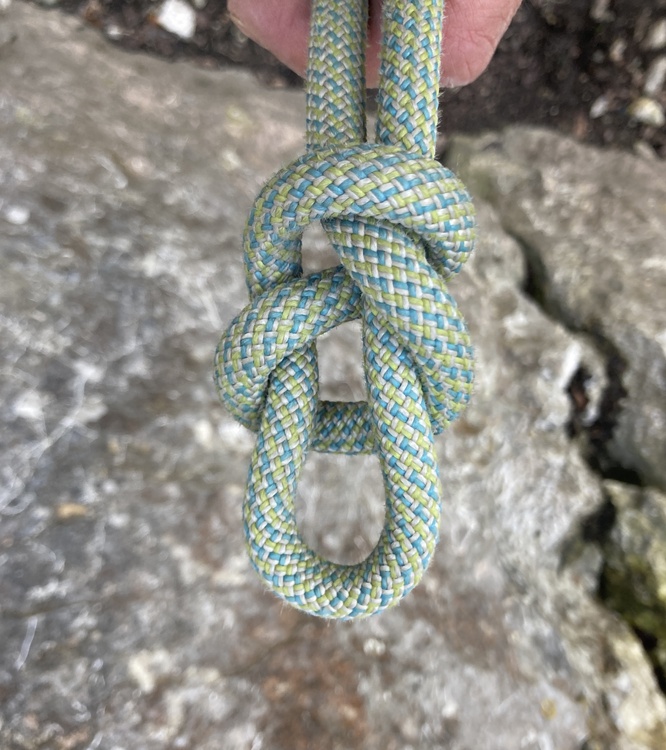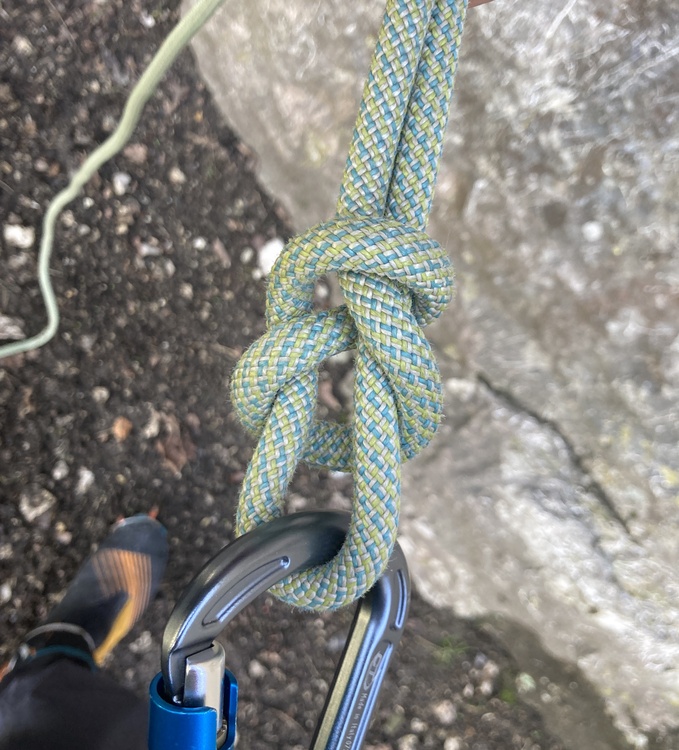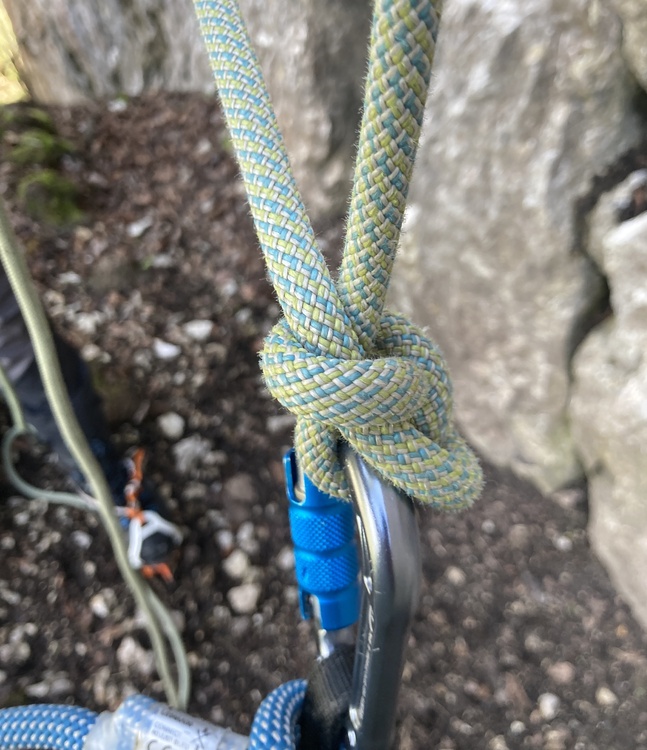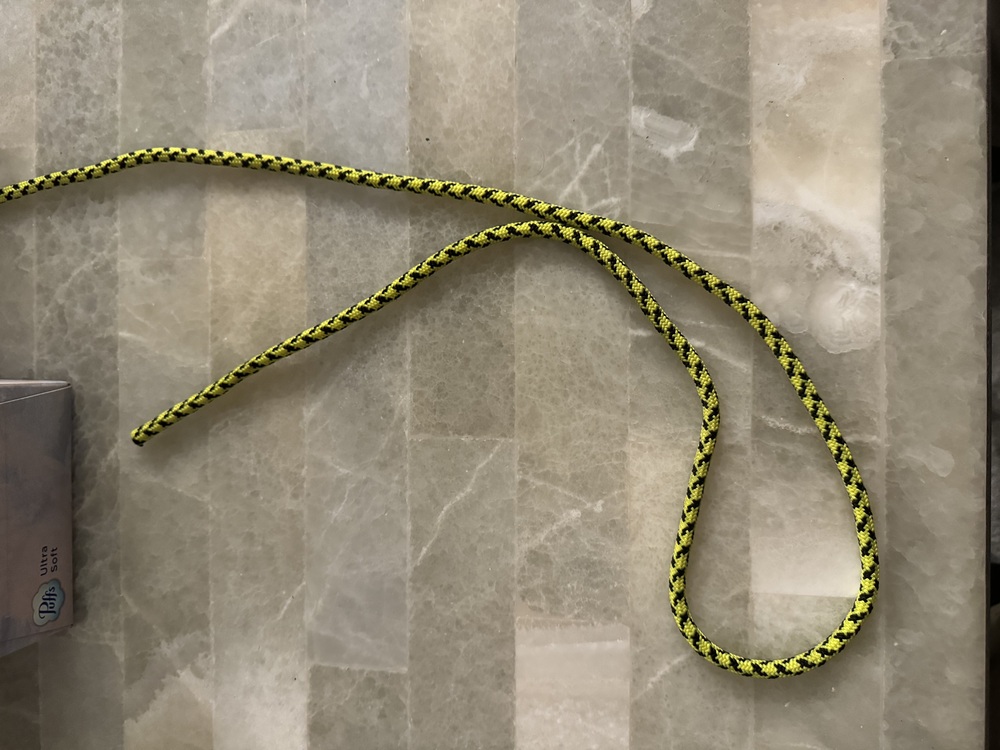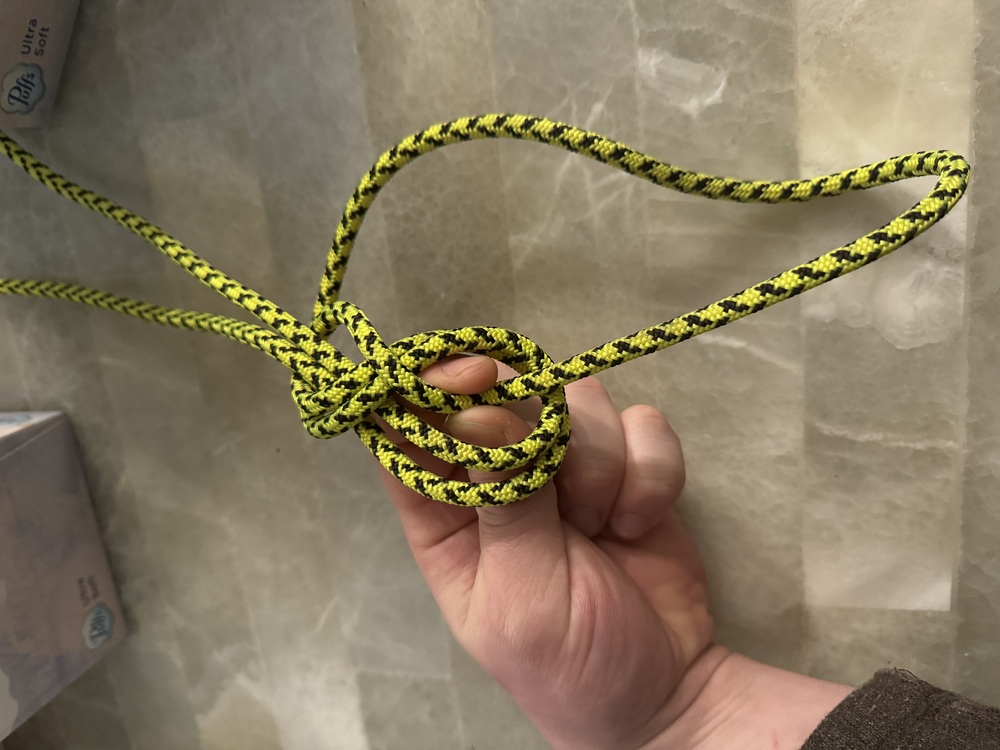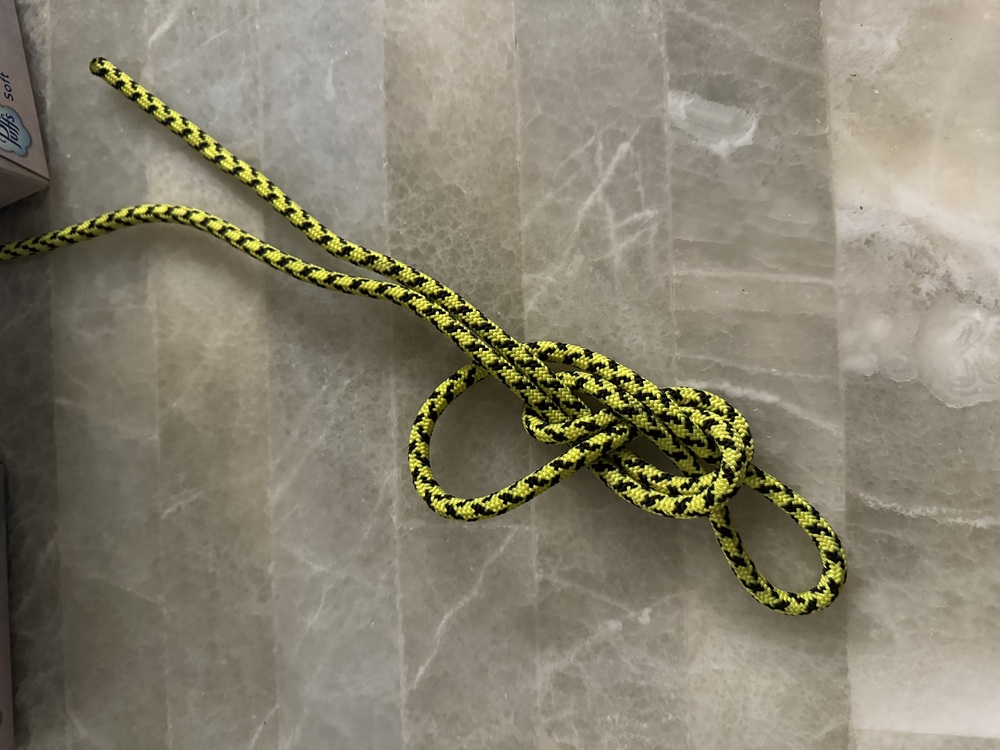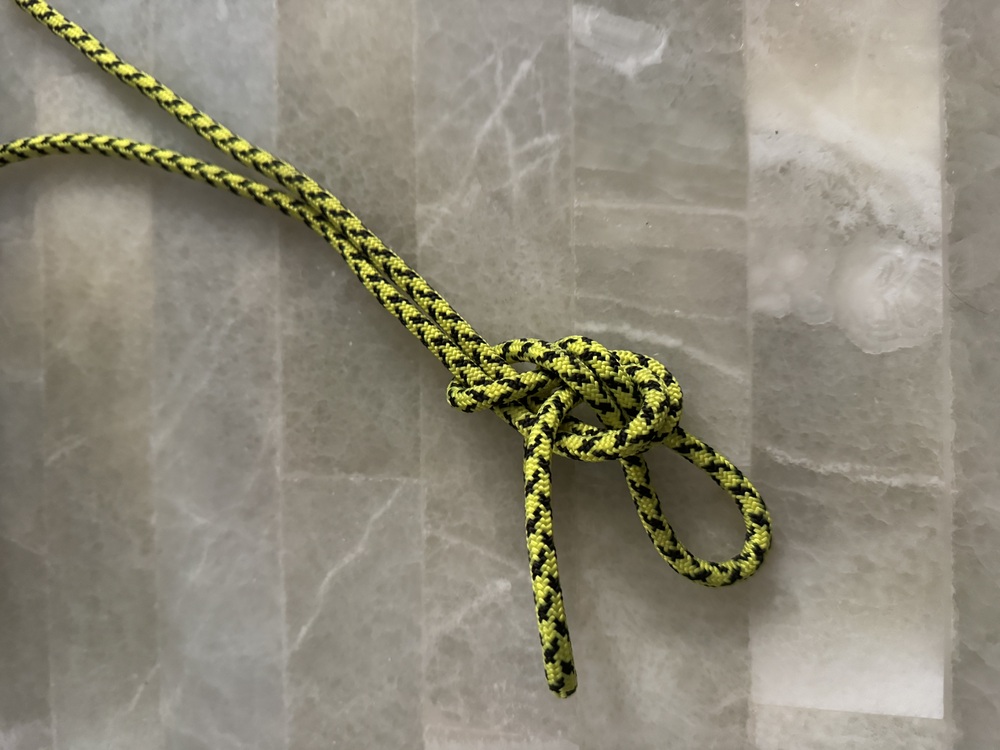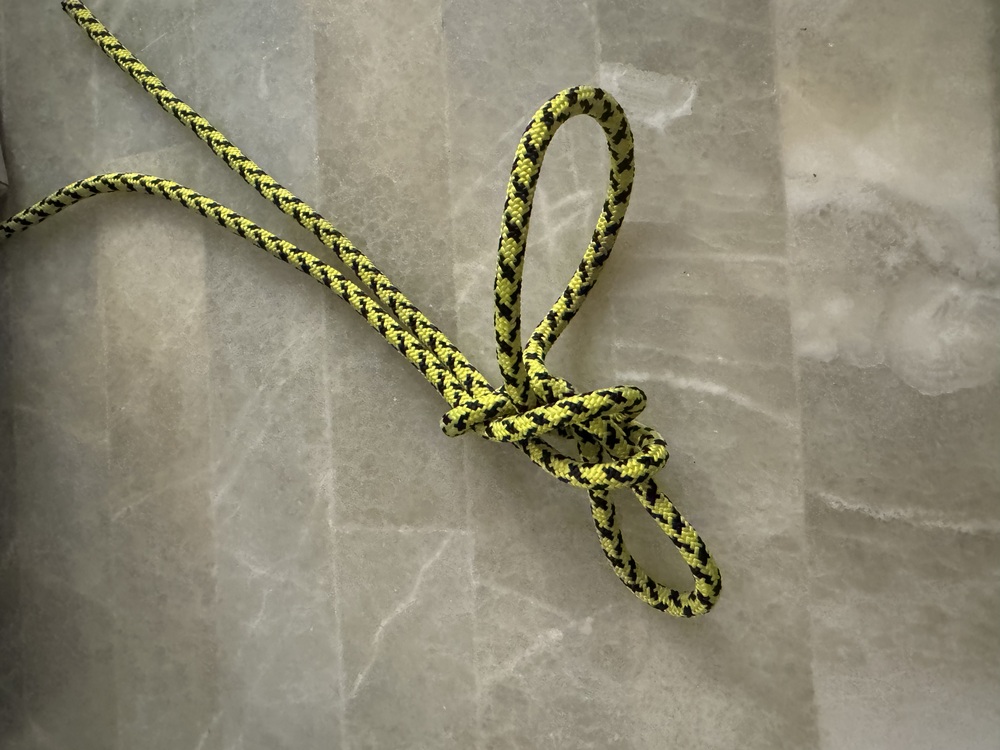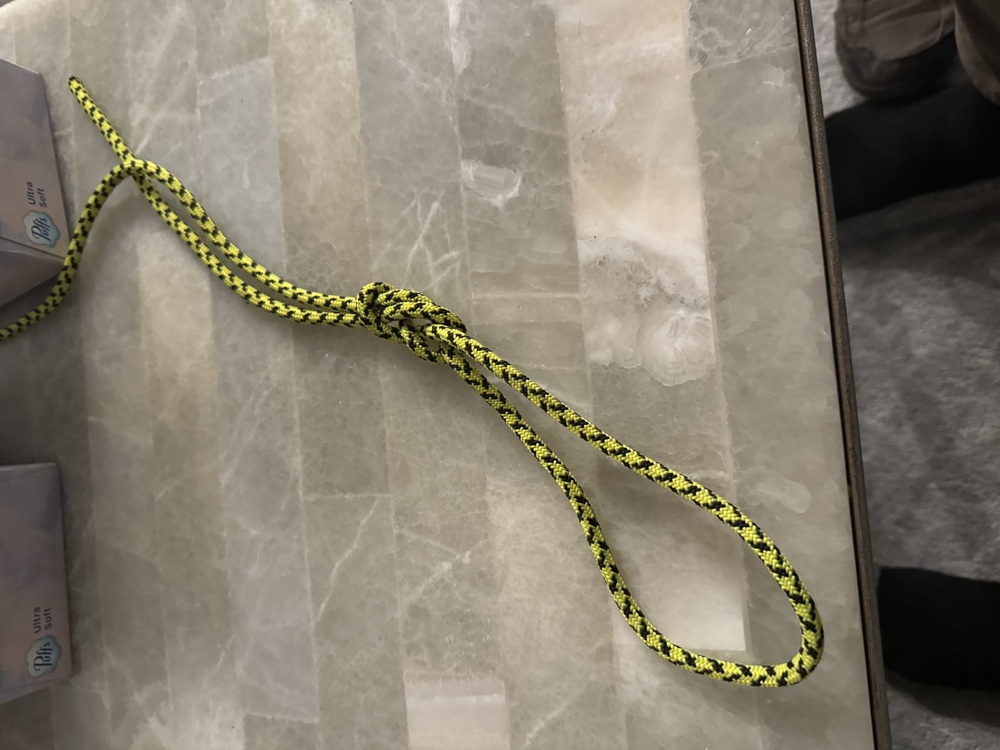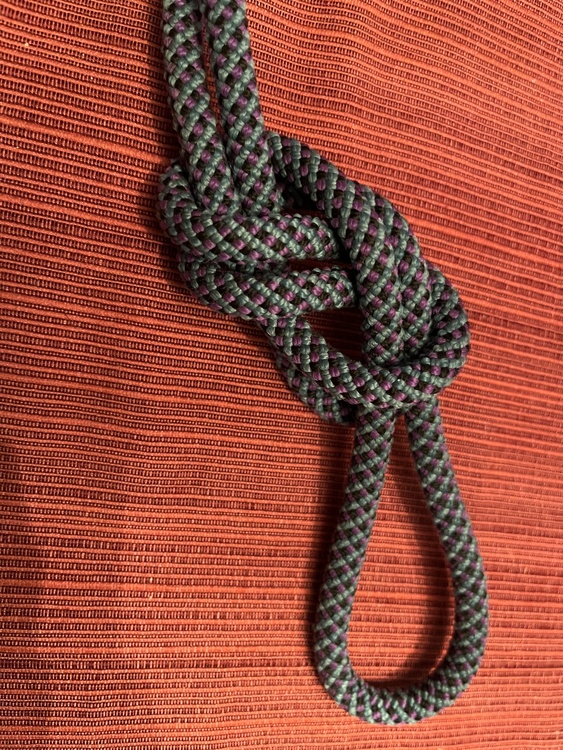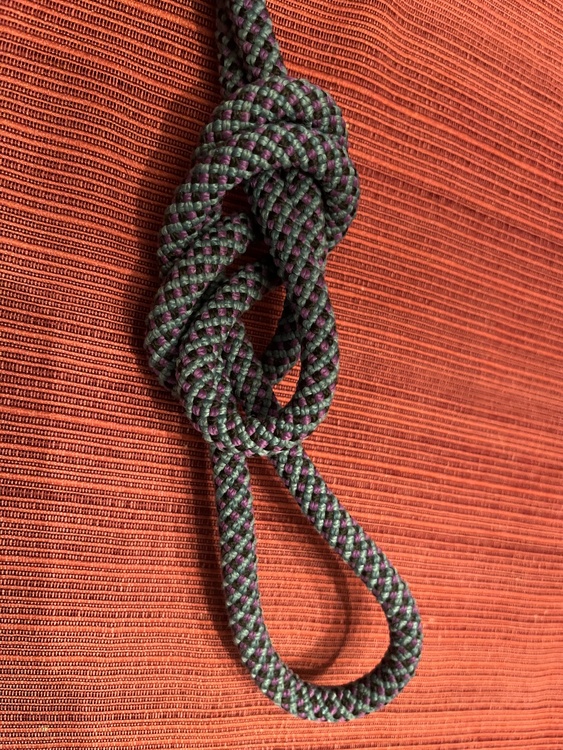Lowering mistake--help deciphering knot
|
|
Hi folks, I made a potentially serious mistake today--this definitely goes into the near miss category, although I'm not quite sure exactly what happened. I was dry tooling. I led a route, reached the anchor, and followed the procedure below, which I have done hundreds of times before, and which I understand to be one standard approach. 1-Clip in with PAS and weight anchor 2-Take a bight of rope from my harness and pass it through the rappel ring 3-On the rope passed through the ring make a figure 8 on a bight 4-Clip figure 8 on a bight to the belay loop on my harness with locking carabiner 5-Untie rope from harness 6-Pull extra strand through rappel ring 7-Double check everything 8-Call for partner to take my weight 9-Check everything again 10-Unclip PAS and lower As soon as I started lowering, the knot on the locking carabiner moved in a strange way--the free end of the rope slid through the knot for a short distance until the knot cinched down tight. I realized there was something wrong with the knot, so I took the free end in my hand, and then tied another knot and clipped that to my belay loop just to be safe. As I continued to be lowered, the original knot stayed tight--it didn't move anymore. When I got on the ground, my partner and I examined it closely. The pictures below show the knot 1) as it appeared when we loosened it and unclipped it from the locking caraboner 2) as it appeared when it was clipped to the carabiner and unweighted and 3) as it appeared when under tension cinched down tight. Can anybody figure out what went wrong here? What knot did I tie? What sequence of intending to tie a figure 8 on a bight and and doing something wrong produced this knot? I don't know if the tail would have or could have slid all the way through the knot if I had not noticed. The tail did slide a short distance, but when the knot cinched down it seemed very tight. Also, the tail was long, because of the lowering procedure. But it still felt like a close call. I generally check everything very carefully, but I obviously I overlooked the knot. I was rushing a little--I was excited to have climbed the route, and I was climbing with a new partner, so both psyche, nervousness, and social feelings were high. The obvious lesson, as always, is to try to be logical and systematic, to check everything, and to remain vigilant about the small, simple, repetitive tasks. Also, I think one potential improvement to the lowering procedure above would be to weight the system fully before unclipping the PAS. This is what I do when rappeling, but I have not made this a part of my regular crag climbing protocol. I think this is because I often pull myself in close to the anchor with my PAS when setting up the lower. I'm so close to the anchor that it doesn't feel like there is enough disdtance to really weight the system. I always wait for my partner to take in the rope before I unclip the PAS, but it's not like I'm bounce testing the system before I commit. I guess the solution would be to get everything set up, extend the PAS to create distance, and then really weight the system. Anyway, any insight here about the knots, procedures, systems, etc would be appreciated. |
|
|
Did Luna tie this knot? JK, glad you're ok. That could have ended badly. |
|
|
It's like you twisted one strand into an 8 and then just pulled a bight of the other strand through the loop. |
|
|
It's a quick-release/slip knot with an extra twist, somewhat useful for trucker's hitches. You're lucky it didn't fail. You probably tied it by grabbing only one strand of the rope instead of the entire bight. |
|
|
Thought it was an overhand on a bight for a second but it's not. I have no idea what kind of knot that is! |
|
|
My suggestion: 1-Clip in with PAS and weight anchor 2-Take a bight of rope from my harness and pass it through the rappel ring 3-On the rope passed through the ring make a figure 8 on a bight 4-Clip figure 8 on a bight to the belay loop on my harness with locking carabiner 4.5-"TAKE" to unload PAS and direct tie-in and load the f8 on a bight. This requires there's enough slack between direct tie-in and f8 on a bight so. 5-Untie rope from harness 6-Pull extra strand through rappel ring Optional: redo the direct tie-in. in case you somehow messed up the f8 on a bight 7-Double check everything
9-Check everything again 10-Unclip PAS and lower It's much harder to mess up the loaded f8 on a bight during your undoing of original tie-in and pas and cleaning your own anchors and etc. |
|
|
You mentioned rushing but didn’t say whether you were talking with anyone (or otherwise distracted) while tying the knot. If so, that’s something to avoid |
|
|
I think I got it. Started out as a figure 8 but some extra slack in the knot was allowed to flip over the end before tightening. |
|
|
Skibo wrote: I thought the same, that it looks like a slip-knot of some sort. It does appear that the extra twist and the carabiner in the loop would probably keep it from pulling free under loads generated from lowering, but wouldn't want to find out by doing it again! Looks like someone has recreated the misstep. This reminds me of a post from a few years ago when someone's partner did the same thing but with just an overhand, and the knot failed shortly after lowering began. Similarly in that case, one strand was missed in the knot-tying process. |
|
|
It's a figure-eight slip knot; the same idea as an ordinary slip knot but with a figure-eight instead of an overhand. If the slipped end had been the free end of the rope, you'd probably be dead now. Glad you had a better outcome! You can produce the result by, at the last moment, not threading the bight through both of the final two loops when forming the knot. So you pass the bight through one of the loops but miss the other loop. It isn't hard to imagine how this can happen. Below are pictures of the situation from two sides of the knot. From one side, the knot almost looks right---what's missing is the second turn at the top---but the missed loop is apparent from the other side. I think one way this can happen is you have some rope weight pulling down while tying the knot; the weight might be enough to shorten a loop and cause you to miss it. (We have the same problem when threading a plaquette for rappelling.) I think the end result is the same as what happens in Alec's description, but I think the failure mechanism described here is more likely. |
|
|
Many thanks for all the responses. I like rgolds change of protocol here...two overhands on a bight as a standard procedure. Overkill? Perhaps. But considering that I screwed it up once, I'll feel better if I change something. Zooming out, two things occur to me. These are not revelatory, but I think they bear repeating. 1-We often obsess about the technical details of one or another relatively complex procedure, like crevasse rescue, solo systems, and so on. What is perhaps more dangerous, what will kill us, so to speak, are mistakes with the mundane, repetitive, simple steps that we repeat hundreds of times, like tying a figure 8, putting on a harness, loading a belay device, and so forth. 2-We deal with lots of different kinds of risk when climbing: objective hazards, human factors, and so on. One of the things that I find hardest to process is the fact that if you climb long enough and consistently enough you will make mistakes. If you're lucky, these mistakes won't kill you, or hurt you terribly. Now, I can hear people thinking, "That's why we have systems, that's why we have checks, that's why we practice, and so on" Yes, of course. But even the most experienced, skilled, and catious climber will eventually and inevitably make mistakes. And if this is true of the best, what chance to we have as middling amateurs? You just have to accept it. Happy to hear more thoughts and ideas, including Luna jokes (expecially Luna jokes!) Bruno |
|
|
Whoa man your knot is whacked. What is wrong with a simple figure 8, it takes 2-seconds. I don't understand all your words. You tied a bogus knot and then failed to recognize it. |
|
|
9-check everything again glad you did not get hurt safety is visual be safe out there |
|
|
Cherokee Nunes wrote: Totally agree Cherokee. I think the more important point is that this kind of mistake--tying a bogus knot and failing to recognize it--is part of climbing. And thinking that it can't or won't happen to you is a dangerous mindset. |
|
|
Cherokee Nunes wrote: He fully intended to tie a figure eight but something went wrong. He wasn't trying to use a "bogus knot." Of course, we shouldn't fail to recognize mistakes. And yet it happens---to everyone sooner or later. I think the point of the discussion is not to proclaim the blatantly obvious but rather to try for something constructive that accounts for the imperfection of human nature. Furthermore, we owe Bruno a vote of thanks for alerting us to this issue and, in the process, predictably exposing himself to critiques whose only point seems to be deprecation. |
|
|
Hey Bruno, Glad you are ok. Props for being open making a mistake and super cool trying to understand what went wrong! Would make a great addition to bergundsteigens „verhauer“ articles! My standard procedure when pulling a bight through the rap rings is to tie an overhand on a bight/overhand loop. It’s the simplest knot I know, my muscle memory can come up with and very easy to visually inspect. Knot strength and releasing it after being lowered is not an issue. br |
|
|
Hey Pavel, thanks for that. I do think I will change from Figure 8 to an overhand, because it seems easier to tie and inspect. Just another step in the continual learning process of climbing. B |
|
|
Bruno Schull wrote: Bruno, thanks a lot for writing this. This kind of mistake is a classic way to have an accident in what appears to be a relatively safe setting. Two observations on your observations:
I’ve forgotten to tie in at the start of a sport route and only realised 3 bolts up. I now use a system to check my tying in (and my belayer’s set up) which I share with all my partners and politely insist they do too when they climb with me. Obviously I check I’ve tied back in each time before lowering from a sport route but I don’t yet have a system to do this. It is entirely possible I could make the same mistake as Bruno, or the mistake that killed an English climbing star of the 70s and 80s and a very good friend. Time to think of a way to make my checking systematic. |
|
|
Bruno Schull wrote: FYI - it takes 1 more trivial step to convert overhand-on-bight to bowline-on-bight. Bowline-on-bight is much easier to untie after jerk loading associated with cycling loading/unloading while cleaning than overhand-on-bight or fig8-on-bight. |
|
|
rgold wrote: This is chilling... I wonder if there have been accidents where the victim committed this exact mistake, but investigators assumed that they simply failed to finish the knot. Climbing safety systems are these little islands of safety in a vast possibility space filled with death. People have been cleaning and lowering off bolted anchors for decades and we're still finding new failure modes. I am so thankful that this one ended well. As far as how to avoid this in the future I would point out three things. First, it is possible to mess up an overhand on a bight: if you don't capture both strands, it creates a slip knot. I've almost done this in the past and fortunately caught it. Second, instead of passing a bight through the rings and tying in via some kind of bight knot on a locker, maybe consider untying, passing the end through the rings, and retying a retraced figure-8. This is what I do when cleaning ring anchors. I think that, since I am very used to tying the retraced figure-8 when tying in to climb, I'm less likely to mess it up than tying a knot that I'm less familiar with. People I respect do it your way, but I think there are some failure modes to be aware of. Third, I really strongly advocate for having your belayer take you tight before unclipping the PAS/slings. This step can avoid many of the potential mistakes that can and have led to avoidable deaths. |
|
|
passing a bite through the rings is done so you remain “ on belay ” and you can not drop the rope
visually check everything before committing climbing is dangerous dumb luck has saved my ass more times than I can remember conversely i believe bad luck has killed be safe out there may luck be with you |

 Continue with onX Maps
Continue with onX Maps Sign in with Facebook
Sign in with Facebook



















